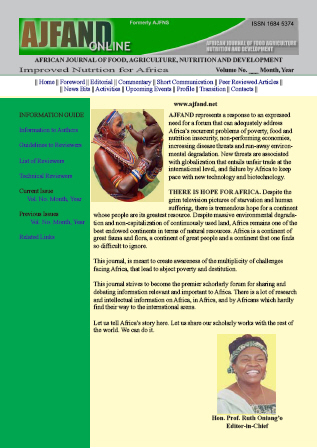
|
African Journal of Food, Agriculture, Nutrition and Development
Rural Outreach Program
ISSN: 1684-5358
EISSN: 1684-5358
Vol. 17, No. 1, 2017, pp. 11497-11517
|
 Bioline Code: nd17007
Bioline Code: nd17007
Full paper language: English
Document type: Research Article
Document available free of charge
|
|
|
African Journal of Food, Agriculture, Nutrition and Development, Vol. 17, No. 1, 2017, pp. 11497-11517
| en |
NUTRITIONAL STATUS AND FOOD CONSUMPTION PATTERNS OF PRIMARY SCHOOL CHILDREN IN ORANGE FARM
Nyathela, T & Oldewage-Theron, W
Abstract
South Africa is regarded as food secure; however, food insecurity and malnutrition are still affecting school-aged children residing mostly in rural areas. This paper reports the nutritional status and consumption patterns of school children from two purposively selected schools located in Orange Farm informal settlement. Data collection methods included socio-demographic background, dietary intakes, anthropometric measurements as well as haematology and biochemical measurements. A socio-demographic questionnaire was used to assess the socio-economic background of the households and a health questionnaire to determine the health background of the caregivers, while a Quantitative Food Frequency Questionnaire (QFFQ) and 24-hour recall were used to determine dietary intake patterns. Anthropometric measurements were obtained in order to find out the prevalence of nutritional status (underweight, wasting and stunting). Haematology and biochemical data collected were used to determine the intake of nutrients and blood levels. Socio-demographic and health questionnaires were captured and analysed using the Statistical Package for Social Sciences (SPSS). Dietary intake, QFFQ and 24-hour food recall were analysed on the South African Medical Research Council FoodFinder® software program. Anthropometric measurements were captured and calculated using Anthro plus then analysed according to the World Health Organisation growth standards while biochemical measurements were analysed using biochemical analyses instrument and transferred to SPSS. The socio-demographic results indicated that household food insecurity contributed to the poor dietary intake of the children as the majority (71.0%) of the caregivers were unemployed and further confirmed by household income of less than R1000 (75.0%) for five to ten household members (44.4%). Non-communicable diseases were not reported; instead, most of the caregivers had skin problems (22.2%) and also suffered from headaches (20.0%) as well as body skeletal affections. Mainly carbohydrate-based food was consumed with limited vegetable and fruit intakes. Low energy intakes were reported with sufficient intakes of most of the micronutrients. Anthropometric results indicated that 5.0% of the children were underweight, only 2.3% of the children were wasted and 33.3% were stunted. Haematological and biochemical data indicated that all the variables were within the normal ranges and thus did not indicate any nutrients or blood level deficiency. Through the findings of this study and other similar studies conducted in South African communities, it is evident that poor nutrition and dietary intakes are still prevalent in primary school children. This increases awareness and the immediate need for nutritional status and food insecurity to be addressed.
Keywords
Nutritional status; consumption patterns; primary school children; Orange Farm
|
| |
© Copyright 2017 - African Journal of Food, Agriculture, Nutrition and Development
Alternative site location: http://www.ajfand.net/
|
|
